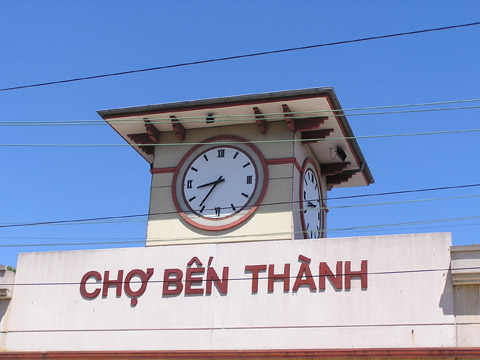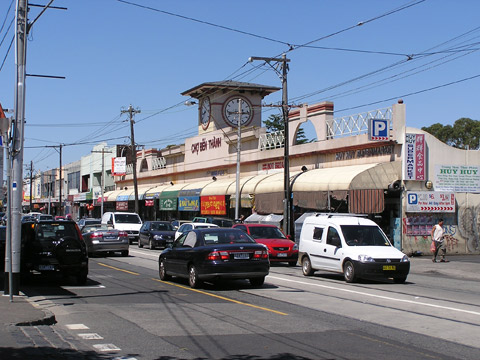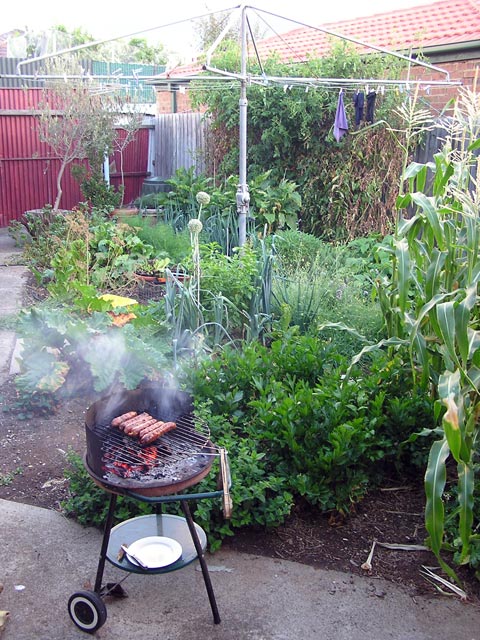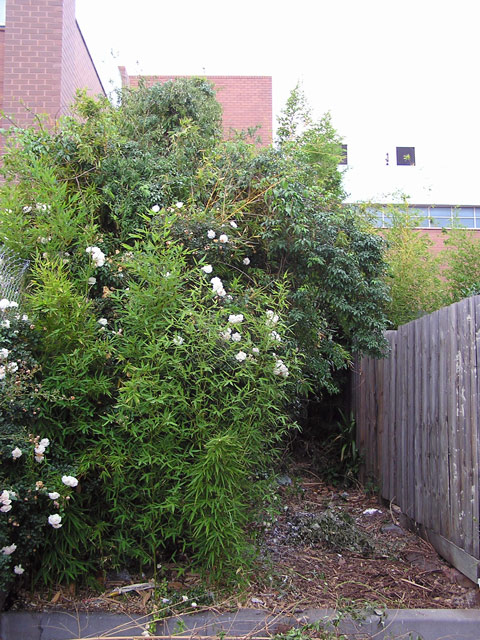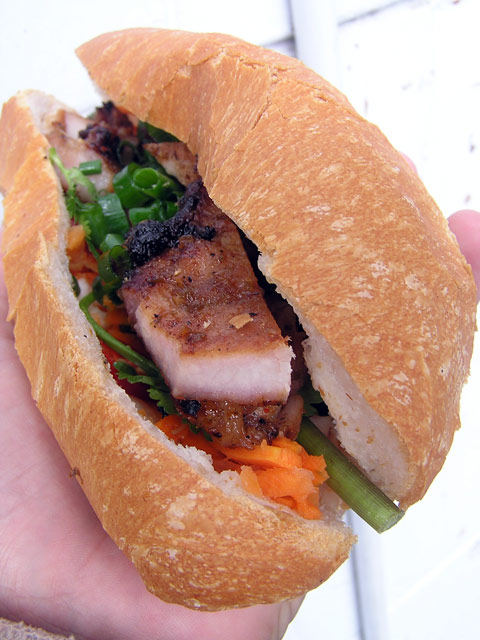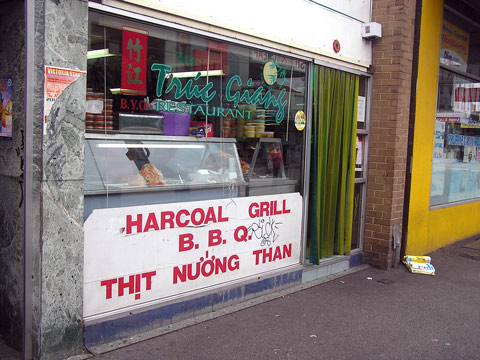Posts Tagged → Melbourne
I can’t believe it’s not Chợ Bến Thành ™
There is nothing like a high degree of architectural verisimilitude to brighten up my day, be it a Big Banana, Giant Merino or in this case, a fake Ben Thanh Market building in the middle of Melbourne. This model of Saigon’s Ben Thanh Market is so accurate that the clocks are all set to the same incorrect times that they are on the real thing.
Rather than the tourist gewgaws that pack most of the Ho Chi Minh City prototype, this one houses one of the more useful Vietnamese grocers in Melbourne, Huy Huy, reliable stockists of the herbiage for great pho (and other Vietnamese soups) such as ngo om (limnophila aromatica), sawtooth coriander (eryngium foetidum), fishwort and a range of basils.
Location: 240 Victoria St Richmond, Vic, Australia.
Sausage Fancier
Once you’ve seen how sausages are made, you’ll want to eat nothing but sausages. This was my first impression of home sausage making; my second was that making sausages is possibly my true calling and that my university loan debts could have been better spent on a meat mincer and practicing the barbecuing arts rather than on undergraduate degrees.
I started with a setup familiar to all new converts to the testaments of sausage making: a copy of Michael Ruhlman and Brian Polcyn’s Charcuterie and George Foreman’s Lean Mean Meat Mincing Machine. That George Foreman lends his moniker to an electric meat mincer is no great surprise to me. I discovered years ago that Foreman had made not less than nine billion American dollars from selling a multitude of appliances in no way limited to the indoor grill. The hypocrisy of adding the word “Lean” to a product that should be pumping out sausages that should be about 25% fat is not lost in me.
If you’re looking to lose weight, eating pork fat stuffed into a tube is not your best option. I’m sure that George would argue that his Lean Mean Meat Mincing Machine means that the home sausage fancier could control the fat content in their sausages just like he himself took control of his 1971 battle with Joe Frazier in Kingston, Jamaica, but I’d rather be eating richer, fattier sausages in moderation than the fat-free simulacra of a sausage. Fat is vital for human survival, just like the footwork Foreman displayed in his 1987 fight with Steve Zouski.
My first batch was perfect. I followed Ruhlman’s basic garlic sausage recipe and added a tablespoon of roughly crushed cumin seeds, chilli flakes, Kampot pepper, then lowered the salt content. The Lean Mean Meat Mincing Machine shudders away. I achieved the “primary bind” that Ruhlman mentions; once ground, the meat turns sticky as the protein breaks down. The casein skin burst only once while stuffing.
I grilled the sausages over charcoal as slowly as possible. I ate them with friends in absolute stunned silence.
I’ve begun eyeing off the greying cut-price meats in the supermarket refrigerators with a single question in mind: will it mince? What else can I stuff? What memories of sausages past can I recapture? How much of my life has been wasted not making my own sausages?
If there is one thing you can expect from this blog in the coming years, it is more sausage.
My basic garlic, cumin and pepper sausage recipe
(based on Michael Ruhlman and Brian Polcyn’s “Fresh Sausage Master Recipe: Fresh Garlic Sausage”)
Yields: about two and a half kilograms of sausages.
The original Ruhlman/Polcyn recipe calls for 3 tablespoons of salt. I ground in two tablespoons of this and fried up a patty of the mince to test the flavour before stuffing the casings. For me, it was salty enough but add more or less to your taste. Real intestine casings are tough to find in Australia. I went with casein.
Ingredients:
1 tablespoon of cumin seeds, coarsely ground
1 teaspoon of dried chilli flakes
1 tablespoon of Kampot pepper (or the best quality black pepper you can get), coarsely ground.
2 tablespoons of the cheapest salt available*.
3 tablespoons of minced garlic
2 cups of white wine
2.5 kilograms of fatty pork meat (approx 25% fat. I used 2 kilos of shoulder to 0.5 kilo of belly)
Method:
Pound the cumin, pepper and chilli flakes in a mortar and pestle until most of the cumin seeds are broken. Finely chop the garlic. Chop the meat into pieces small enough to fit into your mincer. Mix meat, spices and salt together in a bowl and refrigerate for at least two hours.
Soak casein casings in one cup of white wine.
Mince all ingredients into a bowl set in ice, on the fine (0.25cm) grade. Add one cup of wine and mix the mince until it becomes sticky. Fry up a patty of meat to test flavouring, then adjust anything to taste.
Change mincer to stuffer attachments. Thread about a metre of casings over attachment and tie the end in a knot. Pour mince into mincer and stuff away!
Section the giant sausage into odd lengths by twisting the casings – it is much easier to make one metre-long sausage and do this at the end of the process rather than juggling the sausage and the mincer. Charcuterie has a twee picture of measuring a sausage with a ruler as to ensure uniform size; my approach is less anal but equally obscene. Cook over a fire, as slowly as you can bear.
For a much more pictorial recipe, buy Ruhlman and Polcyn’s Charcuterie: The Craft of Salting, Smoking, and Curing.
* – Expensive salt makes no difference when dissolved in food, especially in sausages such as these which are packed with other aromatic components. Jeffrey Steingarten tests this out in It Must Have Been Something I Ate.
The possibility of a guerrilla garden
In the modern city, horticulture is a transgressive sport. Modern urban developments tend to preclude growing fruit and vegetables as a possibility by offering only dark, windy balconies or paving over backyards, only conceding the mere edges to decorative, inedible shrubbery. The walls of suburban McMansions creep closer to the boundaries of their allotments offering scant room for plants.
After having spent the last month touring rental properties in Melbourne, the trend in renovating homes is to eradicate as much greenery as possible and replace it with pavers and a box hedge that looks indistinguishable from a plastic version of itself. The heartening trend towards adding grey water and rainwater tanks hasn’t filtered down to rental properties and most likely won’t while there is the trend for investors to buy houses and flip them onto the rental market as soon as Ikea drops in their cheap stainless-on-softwood kitchens.
These are spaces not meant to grow food.
Urban life in Australia (and much of the Western world) is designed to be separate from farming. There is the occasional community garden and the hardcore few who raze their lawns to plant vegetables anew (and add an obligatory chook shed) but these number amongst the minority. Subsisting in a city, while possible, is not preferable nor socially acceptable.
Behind my new apartment a typical Melburnian bluestone laneway has been curbed off by the local council, creating a semiprivate patch that is now overgrown. A bamboo plant battles for supremacy with an English climbing rose which offers a strange parallel to my eating habits. If I can weed out the overgrowth then there is a small chance to grow my own food and possibly some for the neighbours as well.
The real question is how much food?
And how soon?
“The only reason to move to Sydney would be to kick Bill Granger in his white-panted balls”
Which was how my friend J summarized my decision to move back to Melbourne. I personally have nothing against Bill Granger and he has nothing at all to do with my decision to not move anywhere near him. The other reason to move to Sydney seems that in my absence, the rental property market in Melbourne has gone to hell. The delicious dividend of the hellacious market is the following bánh mì thịt heo nướng, stumbled upon while I was between real estate agents in Footscray.
It is the real deal and unlike the properties that I saw, worth waiting in a queue to get. If I could live inside a sandwich, it would be this one. Flame-grilled chunks of marinated pork meat sit atop pickled, shredded carrot and daikon (instead of green papaya); coriander leaf and stalks; spring onions and fresh chili. The bun is as fresh as you’d find anywhere on the streets of Saigon, the meat even fresher.
The restaurant’s name, Truc Giang, betrays its Southern Vietnamese origins.
Price: $3
Location: Truc Giang Restaurant, 36a Leed St, Footscray, VIC
Phone: (03) 9689 9509

